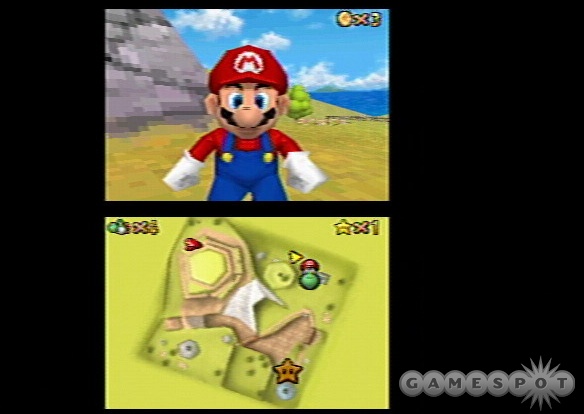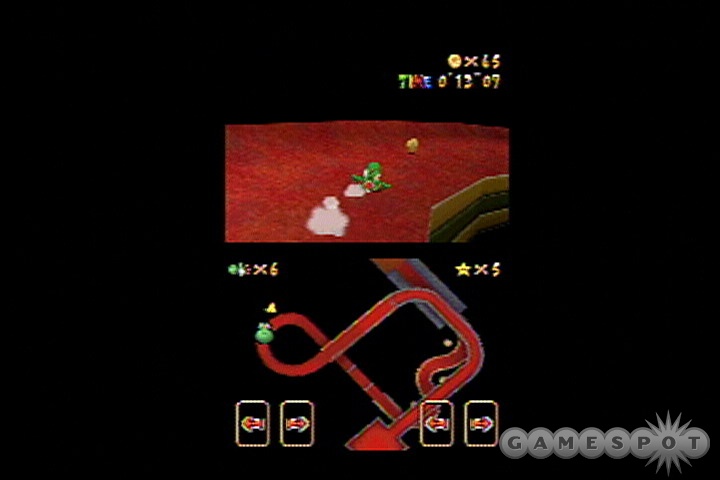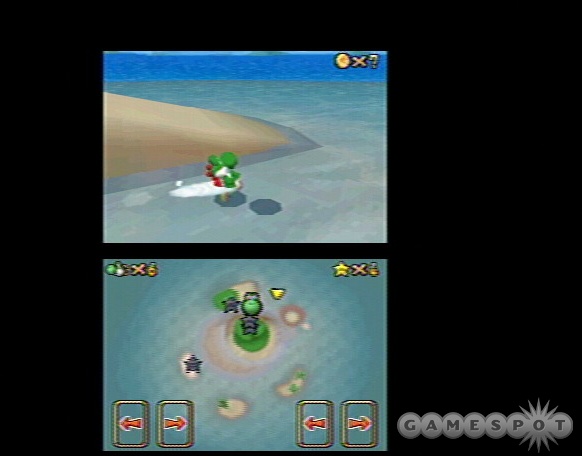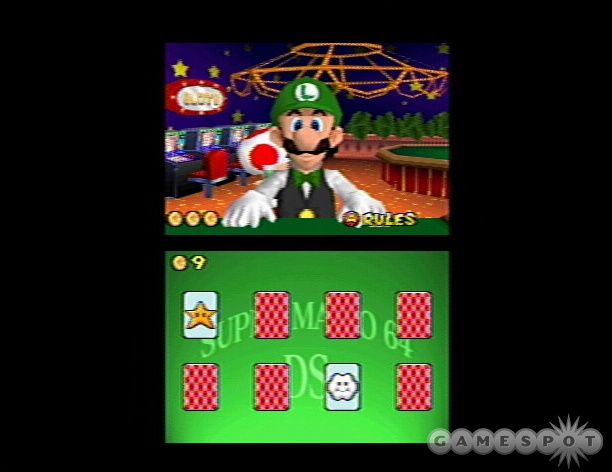Super Mario 64 DS Feature Preview
We take a deeper look at the final retail version of Mario's DS adventure.
In our last look at the retail version of Super Mario 64 DS, we focused on the multiplayer mode. Now, after spending a few days tooling around in the single-player mode, we bring you some insight into how the core game has been changed from the original Nintendo 64 classic, and we relate how it handles with the DS's touch pad.
The single-player game has undergone a number of changes to better support the multicharacter setup. As we mentioned, you'll start out as Yoshi, and you'll work your way through the various paintings in the castle to both collect stars and rescue Mario, Luigi, and Wario. While the structure is close to the original game, there have been a number of tweaks made to improve the experience. The most obvious is an ever-present map on the touch screen that lets you get a look at the whole area you'll be exploring. The stars you'll have to collect are usually shown there to help you navigate to them. Additionally, talking to red bob-ombs will let you see the location of the red coins you'll have to collect, although they aren't permanently marked on the map. Fortunately, you'll usually find more than one bob-omb in a level, so it's not that hard to get your bearings.

The additions to your quest revolve around rescuing your three friends. Each character will be trapped in a room, so you'll have to find the appropriate key for the room's door. As is always the case, the keys are guarded by bosses that require whuppings before giving up the goods. Once you've rescued a character, you can visit the character room and switch to him or her at anytime, which subsequently makes him or her your default player. Each character will handle differently, and each will have his or her own unique abilities that can help deal with the obstacles you'll face. If you happen to choose the wrong default character for a level, the odds are favorable that you'll find a magical hat that will let you assume the appearance and abilities of the best-suited character for that level, which is a nice feature. In addition to finding keys to free your friends, you'll also find keys to unlock the 36 minigames in Princess Peach's rec room that you can play in the separate rec room mode.
Control in the game poses some unique challenges, especially given the differences in the button layouts and input methods for the DS and the Nintendo 64. As we've mentioned in our previous looks, Super Mario 64 DS offers three different control configurations--standard, touch, and dual hand--which you can switch at any time in the pause menu. The standard mode handles much the same way a traditional action game would, with some touch-screen functionality tossed into the mix. You'll move your characters with the D pad, dash with X, jump with B, and attack with A. The right trigger lets you crouch, and the left trigger centers the camera. The Y button lets you cycle through camera modes, which include those perspectives that zoom in and out and also let you switch to a first-person view. The touch screen comes into play for rotating the game camera and for moving your character, although this isn't the ideal configuration, because you'll often find yourself inadvertently hitting the camera rotation buttons on the touch screen.

The proper use of the touch screen can be seen and employed in the touch mode, which requires you to use the touch screen exclusively for moving your character. You'll simply run a finger, stylus, or a finger with the DS thumbpad over the touch screen. The setup offers a fair approximation of the analog control system used in the Nintendo 64 version, although from what we've played so far, it doesn't feel as precise. The face and shoulder button configurations have been tweaked fairly well to compensate for the frequent use of the touch pad. Y rotates the camera left, while X rotates the camera right. A small arrow in the lower left of the touch screen lets you zoom the camera in and out, while the left trigger centers the camera behind you. Meanwhile, the right trigger lets you crouch, B lets you jump, and A lets you attack.
Dual-hand mode presents an even crazier use of the touch screen, and it seems designed to cater to righties and lefties alike. The system centralizes control to the touch screen and either the D pad or face buttons. Movement is still handled by the touch screen, but more camera controls have been added to let you both rotate and zoom by pressing the buttons in the lower right-hand side of the screen. The rest of the controls are mirrored on either side of the screen on the D pad and face buttons. Up or the X button lets you jump. Right or A lets you attack. Down or B lets you crouch. And, finally, left or Y centers the camera.

Even with all the aforementioned variety, you'll find that it's going to take some time to get a grip on how Mario handles, and it's going to take longer still to determine the best way to use the touch screen. We're still trying to find our preferred handling setup, but at the moment, we're alternating between standard and dual hand depending on the situation. Jumps are still a problem, regardless, but hopefully more practice with the setups will sort that out.
After taking some time to go back and revisit the original Super Mario 64, we have to say that Super Mario 64 DS is a solid approximation of the original, and it offers a fair share of "enhancements" that succeed to varying degrees. First and foremost, the characters models are well done and are visually on par with the original. In fact, the DS's smaller screen actually helps the overall visual quality by smoothing over some of the rougher textures from the N64 offering. You may also notice a bit of an original PlayStation sheen to the visuals, since some of the filtering used in the Nintendo 64 game appears to be absent in the DS version. One of the biggest tweaks to the presentation is the color palette, which has been muted from the bright, cartoony original. You'll notice that the deep oversaturated red, greens, browns, and blues have been given some gradients, resulting in a more blended look. The palette change also ties into some of the other tweaks made to the presentation, including the removal of some of the cartoony touches from the original, such as the faces on the moving blocks in Whomp's Fortress. There have been some layout tweaks made to many areas, largely to support the new or tweaked objectives in the levels. In the cases we've seen so far, this has resulted in a reduced risk of plummeting to your death, which is always a good thing. The camera remains solid when left to its own devices, with only occasional hitches on objects, which is on par with the first game. In terms of performance, the game runs fairly smoothly. In some cases, it offers more stability than the original...at least based on what we've played so far.

The audio in the game is basically the same as the original and is fleshed out some with a few new sound effects. Some of the old-school sound effects have been changed. So, for example, when Mario punches enemies, you'll now hear the old-school head-bonk effect, as opposed to the effect used in the Nintendo 64 game. The voice samples and tunes all remain true to the original, although Mario's gotten a few new lines, and you'll now hear sound samples for Yoshi, Luigi, and Wario when playing as one of them. Talking with non-player characters still yields singsongy gibberish that changes in cadence to simulate speech.
Overall, we've got mixed feelings about Super Mario 64 DS right now. On the one hand, the gameplay still has a powerful appeal that certainly speaks to why the original was so influential. The addition of new content is a nice touch, and it helps freshen the nearly 10-year-old game. It's also nice to be able to have a meaty 3D platformer to play on the go. On the other hand, the touch-screen support and some of the other changes dull some of the aforementioned appeal by complicating the original offering's elegant simplicity. We've still got a ways to go through the game before we formulate our final opinion, so until our full review is unveiled later this week, check out some additional direct-feed movies of Super Mario 64 DS on our media page.
Got a news tip or want to contact us directly? Email news@gamespot.com
Join the conversation